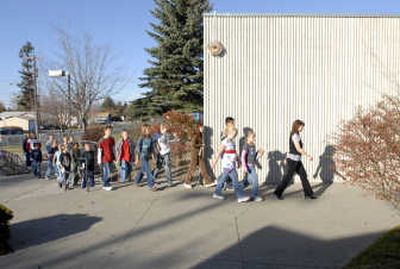CV asks community for ideas

If patrons of Eastern Washington’s second-largest school district were in charge of solving the worsening classroom shortage, Central Valley students could begin learning in staggered shifts or be bused out of their neighborhoods.
Another solution might be consolidating the three Spokane Valley school districts – Central Valley, East Valley and West Valley – into one unified district.
The district could also cancel school programs, such as those for gifted students or the home school cooperative, to free up classrooms. Or, another construction bond could be considered to build much-needed elbow room.
Those were among the ideas presented to the CV school board Monday by the district’s Facility Options Committee.
After three failed attempts to pass multimillion-dollar construction bonds to address the district’s enrollment surge, the school board convened the committee of parents, district staff, community members and students and asked them to go out into the community to gather ideas.
“Our hope was that, if they aren’t going to listen to us, maybe they will listen to their community members,” said Debra Long, school board president. “We said, ‘You tell us what to do next.’ ”
It’s an approach that’s drawing the interest of school officials across the Inland Northwest as districts struggle to rebuild voter confidence amid skyrocketing property tax bills. Deer Park schools, for example, experimented with a similar outreach effort after several failed attempts to win voter approval to build new schools in that rapidly growing Spokane County community. In nearby Coeur d’Alene, a long-range planning group of parents, administrators and principals has been asked to prioritize construction projects.
Back in Central Valley, school officials had already suggested implementing extreme measures like year-round school, double shifting and canceling program, and what they heard was a resounding “no way,” Long said.
The committee spent the past seven months researching every option the community could think of. The result was 32 options the board could consider, broken down by pros and cons in a 169-page report.
Some of the solutions offered by the community were those already suggested by the school board, like double shifting, year-round school and additional portable classrooms.
Other options suggested by community members include pushing for impact fees from developers; creating freshmen centers or grade-specific centers, like the popular kindergarten center the district opened last year; increasing class sizes; refusing out-of-district transfers; changing boundaries; and leasing space from East Valley School District, which has unused class space because of a dwindling population.
“Honestly, I really do feel like we considered every option,” Anne Martin said.
Martin was charged with looking at the option of asking voters to approve yet another, slightly smaller construction bond.
“The thing we heard was that the bonds were too large” and that the schools were too fancy, Martin said. The last bond of $75 million would have paid for a new middle school and elementary school near Liberty Lake, and improvements to other school buildings.
Possible bond options would be to build just a new elementary school or middle school, but not both. Another possibility might be to build a new elementary and remodel three other schools.
“If another construction bond is to appear on the ballot in February, we would have to make the decision very soon,” Long said. The district has 45 days before the election to file. “Is 45 days enough time to convince the community?”
The committee also considered options that weren’t viable, such as doing away with all administrators, Martin said.
“Obviously, that isn’t realistic,” she said.
Others included allowing the Liberty Lake community to create its own school district within existing CV boundaries – state law does not allow a new school district to be formed from another district – or using space at the old University High School.
When the district built the new U-Hi in 2002, it accepted state matching funds to help pay for the project. Because state funds are based on available space, if the district began using the old high school for regular K-12 instruction, it could face financial penalties, including no future funds for construction.
“We signed a contract that says the building cannot be utilized,” said committee member Kathy Jackson.
Currently, the space is leased to Valley Christian School and also houses CV’s special education preschool program and part of the school district’s bus fleet.
Board members said they will take the committee’s report into consideration as they create a plan to address the growth issues. Since 1996, the district has grown by more than 1,500 students.
“This isn’t something we plan to just put on the shelf,” Long said. “We knew we would be OK this year, but what about next year? That’s the prevailing question.”